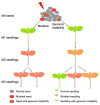From Classical Radiation to Modern Radiation: Past, Present, and Future of Radiation Mutation Breeding
- PMID: 34993169
- PMCID: PMC8725632
- DOI: 10.3389/fpubh.2021.768071
From Classical Radiation to Modern Radiation: Past, Present, and Future of Radiation Mutation Breeding
Abstract
Radiation mutation breeding has been used for nearly 100 years and has successfully improved crops by increasing genetic variation. Global food production is facing a series of challenges, such as rapid population growth, environmental pollution and climate change. How to feed the world's enormous human population poses great challenges to breeders. Although advanced technologies, such as gene editing, have provided effective ways to breed varieties, by editing a single or multiple specific target genes, enhancing germplasm diversity through mutation is still indispensable in modern and classical radiation breeding because it is more likely to produce random mutations in the whole genome. In this short review, the current status of classical radiation, accelerated particle and space radiation mutation breeding is discussed, and the molecular mechanisms of radiation-induced mutation are demonstrated. This review also looks into the future development of radiation mutation breeding, hoping to deepen our understanding and provide new vitality for the further development of radiation mutation breeding.
Keywords: classical radiation; mutagenesis; mutation breeding; particle radiation; space radiation.
Copyright © 2021 Ma, Kong, Sun, Wang and Guo.
Conflict of interest statement
The authors declare that the research was conducted in the absence of any commercial or financial relationships that could be construed as a potential conflict of interest.
Figures




References
-
- Brunner H. Radiation induced mutations for plant selection. Appl Radiat Isotopes. (1995) 46:589–94. 10.1016/0969-8043(95)00096-8 - DOI
-
- Abe T, Kazama Y, Hirano T. Ion beam breeding and gene discovery for function analyses using mutants. Nucl Phys News. (2015) 25:30–4. 10.1080/10619127.2015.1104130 - DOI
Publication types
MeSH terms
LinkOut - more resources
Full Text Sources
Miscellaneous

